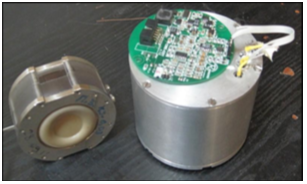|
Miniature Planetary Seismometers |

|
Home | Contact Us | Research | Publications | People |
|
Schematic of MET seismometer sensing cell and assembled sensing package.
Understanding the structure, dynamics, and evolution of comets, asteroids, and planets requires a detailed imaging of their interiors. Constraints on interior structure provide unique information regarding the environment from which planets condensed and subsequently differentiated, and in general are the primary way we build an improved understanding of the formation, evolution, and current state of these bodies. To obtain a first-order constraint on the interior structure of planets and asteroids, the most typical approach is to measure its pole orientation and libration, moment of inertia, gravitational field, and topography to develop models of its interior. However, demonstrated by myriad terrestrial investigations, seismic methods are the only ones with the potential for high resolution mapping of internal heterogeneities and layering from the surface to the center. Efforts to develop planetary seismometers using mass-spring systems have yielded modern first-generation instrumentation. Both very broadband (response from ~10 Hz to 0.01 Hz and lower) and short period (responses centered from 1 Hz to 10s of Hz) seismometers have been in flight development for years. However, sensitive instruments with extended dynamic range and broad bandwidth have been, until now, high power, high mass, and high cost, and are currently available only for lander-based missions with single instrument, such as the planned InSIGHT Discovery mission. Fundamental new advances in how we image planetary bodies will come only with a major technological advance in a broadband seismometer flight instrument. At present, a robust, low power, low mass, small form factor, and relatively low cost broadband seismometer that can be deployed flexibly across a broad range of mission types does not yet exist. One major issue is that landing and deploying a seismometer on other planets represent great challenge from the stand-point of mission design. The traditional seismometers, due to inherent limitation of the solid mass-spring system, are fragile and have strict requirement on installation angel (<5o in vertical). The requirement of having tolerance of high shock force and easy installation is then currently the bottleneck of planetary seismic instruments. In collaboration with seismologists and planetary geologists, as well as industrial partners, we are one of a few of leading research groups developing high performance micro seismometers for space missions using microfabrication technology. Different from traditional seismometers using a solid-mass-spring system, our seismometers based on novel molecular-electronic-transducer (MET) technology can sense the movement of a liquid electrolyte between electrodes by converting it to electrical current. The core component in the MET seismometer is the molecular electronic cell, Four electrodes configured as anode-cathode-cathode-anode (ACCA), separated by dielectric spacers, span the width of channels filled with an electrolyte containing iodide ions. Holes through the electrodes and dielectric spacers allow fluid to flow through the channels. The ends of the channel are capped by high-flexibility rubber diaphragms, allowing the fluid to behave inertially. Each anode-cathode pair in the cell is actually an electrochemical cell. When the electrodes are biased with electrical voltage, reversible chemical reactions transfer charges between anode and cathode via ions in the electrolyte. Therefore, an electrical current is established. Without fluid motion, diffusion is the only mechanism to transport the ions in solution. A symmetric pattern of ion concentration develops, resulting in and symmetric current in ACCA electrode pairs. In the presence of an external ground acceleration, the inertial driving force then is applied on the liquid electrolyte, which will produce asymmetry in the electrical current. By read out the current differential, the measurement of ground motion is demonstrated. In this regard, our seismometers have not only good performance on noise floor and bandwidth, but also the unique advantage of ultra high shock tolerance (at least 23kG) and no limitation on installation angle. This unique solution enables well desired planetary deployment means, such as using planetary penetrators, which are not possible with traditional seismometers. Possible missions include exploring Mars, Europa and asteroids.
· H. Huang, M. Liang, R. Tang, J. Oiler, T. Ma and H. Yu “Molecular Electronic Transducer-Based Low Frequency Accelerometer Fabricated With Post-CMOS Compatible Process Using Droplet as Sensing Body” IEEE Electron Device Letters, Electron Device Letters, IEEE (Volume:34 , Issue: 10 ) pp: 1304 - 1306 DOI: 10.1109/LED.2013.2277541 (pdf) · H. Huang, B. Carande, R. Tang, J. Oiler, D. Zuitsev, V. Agafonov and H. Yu, “A Micro Seismometer based on Molecular Electronic Transducer Technology for Planetary Exploration” Applied Physics Letters, 2013, Volume: 102 Issue: 19 Article Number: 193512 DOI: 10.1063/1.4806983 (pdf) · H. Huang, V. Agafonov and H. Yu, “Molecular Electric Transducers as Motion Sensors: A Review” Sensors 2013, 13(4), 4581-4597; DOI: :10.3390/s130404581 (pdf) |


